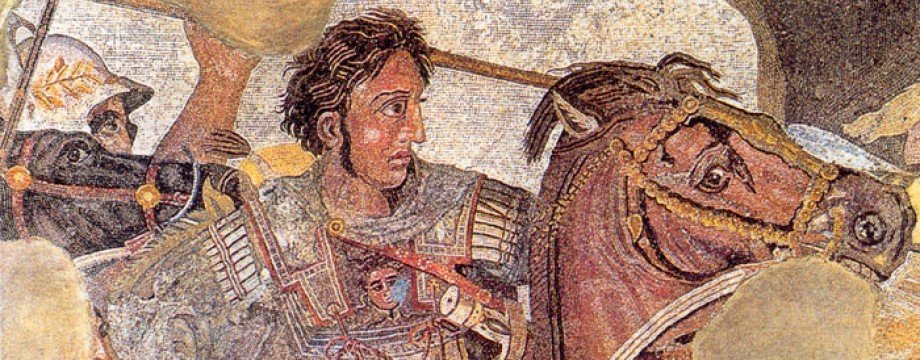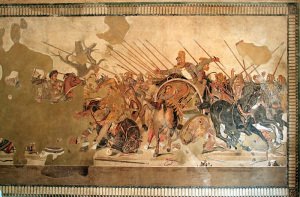Daily Diodorus
Vol. VIII. Book XVII Ch. 33, 34 (Loeb Classical Library)
Read the other posts in this series here
The Headlines
Macedonians and Persians Clash at Issus
Darius Nearly Killed by Own Horses
Persian Cavalry Routed
Macedonian Phalanx Inflicts Heavy Casulaties
Alexander Wins Battle
Darius Flees
The Story
Alexander’s scouts were the first people to see Darius’ army. They reported to the king that it was approaching in battle formation. The scouts were afraid but ‘Alexander grasped that this was a god-given opportunity [for him] to destroy the Persian power in a single victory’. He ‘roused his soldiers with appropriate words for a decisive effort’ and prepared the army for battle.
Didorus spends next to no time on the Macedonian army’s battle order. He explains that Alexander lined the cavalry up in front of the infantry, that Alexander placed himself on the right wing (the king’s traditional location), and that the Thessalian cavalry - ‘outstanding in bravery and skill’ - was posted on the left wing.
The battle began once the two sides came ‘within missile range’.
One The Persians launched their missiles in such numbers that, rather comically, ‘they collided with one another in the air’. Less amusingly for the Persians, this ‘weakened the force of their impact’..
Two The trumpeters ‘blew the signal of attack’. The Macedonians raised their war cry first. The Persians responded and ‘the whole hillside bordering the battlefield echoed back the sound’ of half a million men. What a racket that must have been!
Three Alexander looked around anxiously for Darius. Seeing him, he ‘drove hard with his cavalry’ at the Great King.
Four As Alexander rode towards Darius, ‘the [cavalry] battle raged indecisively’ for the two sides were ‘evenly matched’. So much for the Persians being so effete.
Five Diodorus describes how men on both sides died on their feet, facing the enemy, ‘their fury [having] held to the last breath’. It must have been a truly frightening experience. The high numbers of men involved meant that ‘[n]o javelin cast or sword thrust lacked its effect’.
Six The officers on both sides also fought bravely, inspiring their men as they did so. Interestingly, Diodorus singles out a Persian for praise rather than a Macedonian. Oxathres was Darius’ brother, ‘and a man highly praised for his fighting qualities’. Seeing Alexander ride at Darius, Oxathres feared for the Great King’s life but was also ‘seized with a desire to share his brother’s fate’. He lead his men forward. They intercepted the Macedonians and ‘slew many of them’.
Seven The Macedonians, however, were the better soldiers and soon ‘many bodies’ lay piled up around Darius’ chariot.
Eight ‘Many of the noblest Persian princes’ died protecting their king. Diodorus names Antixyes, Rheomithres and the satrap of Egypt, Tasiaces, as being among the dead. Many Macedonians also fell but they are not named. Diodorus does mention, however, that Alexander ‘was wounded in the thigh’.
Nine Darius’ horses were heavily wounded and started to panic. They ‘came close to carrying off Dareius into the midst of the enemy’ but he managed to bring them under control just in time. Despite this, when a second chariot was brought to him, Darius ‘changed over to it’. The change was not carried out calmly. According to Diodorus, ‘in the face of constant attack [Darius] fell in a panic[ed] terror’.
The Alexander Mosaic, below, captures the moment that Darius, wild-eyed with fear, flees from the battlefield in the second chariot.
Ten Seeing their king’s abject fear, ‘the Persians with him turned to flee’. Soon, ‘the whole Persian cavalry’ was in flight. Diodorus reports that in their haste the horsemen ‘clashed and trampled on one another’.
Eleven Didorous does not state when the Macedonian and Persian infantry began to fight. When they did, though, the contest was a brief one. The destruction of the Persian cavalry had ended the Persian army’s effectiveness as a fighting force.
Twelve As it happens, Didorus doesn’t give the battle’s casualty figures until the end of Chapter 36. I think, though, it makes sense to give the numbers here as Chapters 35 and 36 concern the aftermath of the battle.
Persian Dead
- Cavalry ‘not less than ten thousand’
- Infantry ‘more than one hundred thousand infantry’ (and the Macedonian phalanx only fought them briefly!)
Macedonian
- Cavalry One hundred and fifty
- Infantry Three hundred
Comments
The Battle of Issus followed the same pattern as that of the Granicus River - A cavalry battle followed by a brief confrontation between the infantry of the two armies.
Given that the Thessalian cavalry were regarded so highly by Alexander, I wonder why did it not fight on the right wing? I don’t know the answer to this but perhaps it was because the soldiers on the left were the ‘weakest’ in the line so the best cavalry were placed there to help them out.
I’ve also been wondering about the significance of Diodorus singling Oxathres, a Persian, out for praise during the battle rather than a Macedonian. It can’t be bias as he did the same for Black Cleitus at the Granicus. I am guessing that, like a good reporter, Diodorus is just going where the story takes him.
Here are some of the significant Persian dead as given by the other Alexander historians, and mentioned in the Footnotes.
Arrian Arsames, Atizyes, Bubaces, Rheomithres, ‘Sabaces of Egypt’
Curtius Atizyes, Rheomithres, ‘Sabaces, satrap of Egypt’
According to the Footnotes it is possible that Diodorus’ Antixyes is the Atizyes who he mentions in Ch. 21 as dying at the Battle of the Granicus River but this is not certain. Note also that the satrap of Egypt is given a different name by Diodorus than that provided by Curtius and Arrian.
Finally, the Footnotes remind us that Ptolemy describes the Persians fleeing from the Issus battlefield as doing so across ‘a deep gully on the piled up bdies of the dead’. It is a very evocative description for a writer who I get the impression is supposed to have been a rather straight-down-the-line type of man. At any rate, it leads the Footnotes to say wryly, ‘[e]ven a king, it seems, might draw the long bow on occasion in writing history’. I had never heard that idiom before. I shall certainly try and use it again.
A Persian Cabbie Writes
I had that Darius in the back of my chariot once. ‘e says to me, ‘e says, I want to go ‘ome pronto and I’ll pay you double if you take the direct route. I says, Guv, it’s a good job you ain’t American otherwise you would ‘ave said direct route and I would ‘ave ‘ad to say, In fairness, guv, that’s the way you just came. He looked at me like I was mad. Lovely, fellow, though. Very quiet. Let me do the talking. A shame the roads were murder.

